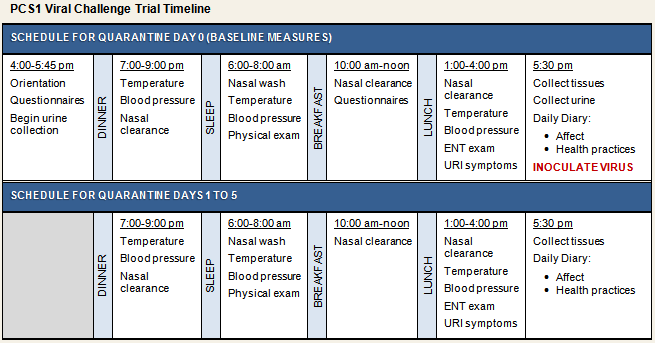
Pittsburgh Cold Study 1
Study Description
Pittsburgh Cold Study 1 (PCS1) was a prospective viral challenge study conducted from 1993-1996 among healthy volunteers ages 18-55 (mean 29.1; SD 9.1). This study replicated and extended the association between psychological stress and common cold susceptibility found in the British Cold Study (BCS). For example, PCS1 elaborated upon the self-report questionnaire used in the BCS to measure major stressful life events by instead assessing the occurrence of major stressors with the Life Events and Difficulties Schedule (LEDS)—an intensive interview measure of life stress. The richness of the data obtained by using the LEDS allowed for examination of the extent to which stressors occurring in differing life domains (interpersonal difficulties, work stressors, other) and persisting for differing lengths of time (<1 month, 1-6 months, 6-24 months, >24 months) were associated with susceptibility to the common cold. PCS1 also focused on the role of social integration (number of social roles [domains] in which a person has social contact) in common cold susceptibility. Several other psychosocial variables were also assessed in this study, including social status and personality (Big 5). Pre-challenge biological measures included stress hormones (cortisol, epinephrine, norepinephrine), and both functional (natural killer [NK] cell cytotoxicity) and quantitative (white blood cell counts) measures of immunity.
Participants were 125 men and 151 women from the Pittsburgh, Pennsylvania metropolitan area who responded to newspaper advertisements and were judged to be in good health after a medical examination. Participants were compensated $800 for their participation. At baseline, participants completed a telephone screening followed by an in-person health evaluation by study physicians to assess study eligibility (see Human Subjects for information on additional inclusion and exclusion criteria). After completing baseline psychosocial questionnaires and biological assessments, participants were administered nasal drops containing either rhinovirus 39 (RV39; n=147) or rhinovirus 21 (RV21; n=129). They were then followed in quarantine for 5 days and monitored for development of infection and objective signs of illness (see viral challenge timeline below). Approximately 28 days after virus exposure, blood was collected for serological testing. Volunteers were considered to have a cold if they both were infected with the study virus and met illness criteria.
